List of Roman wars and battles
 |
| Part of a series on the |
| Military of ancient Rome |
|---|
|
|
The following is a List of Roman wars and battles [1] fought by the ancient Roman Kingdom, Roman Republic and Roman Empire, organized by date.
8th century BC
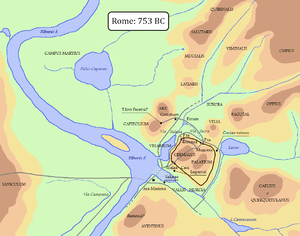
The city of Rome in 753 BC
7th century BC
6th century BC
508 BC Siege by Etruscans (forces in blue) of Rome (forces in red).
- Pometian Revolt (503-502 BC)
- 502 BC – Battle of Pometia – The Romans put down the revolt of Pometia and Cora.
- Roman-Sabine wars
- 509 BC – Battle of Silva Arsia – The Romans defeated the forces of Tarquinii and Veii led by the deposed king Lucius Tarquinius Superbus. One of the Roman consuls, Lucius Junius Brutus, is killed in battle.
5th century BC
- First Latin War (498-493 BC)
- 497 BC – Battle of Lake Regillus – Aulus Postumius Albus Regillensis defeats the Tarquinii, led by Tarquinius Superbus.
- 495 BC – Battle of Aricia – consul Publius Servilius Priscus Structus defeats the Aurunci.
- 482 BC – Battle of Antium – the Volsci defeat consul Lucius Aemilius Mamercus.
- 482 BC – Battle of Longula – consul Lucius Aemilius Mamercus defeats the Volsci the day after his defeat in the Battle of Antium.
- 458 BC – Battle of Mount Algidus – Cincinnatus defeats the Aequi
- 446 BC – Battle of Corbio – Titus Quinctius Capitolinus Barbatus leads Roman troops to defeat the Aequi and the Volsci.
- 480 BC – Battle of Veii (480 BC) – Consuls Marcus Fabius Vibulanus and Gnaeus Manlius Cincinnatus win heavy battle against Veians and their Etruscan allies. Consul Gnaeus Manlius Cincinnatus and former consul Quintus Fabius are slain.
- 477 BC –
- Battle of the Cremera – All the Fabii except Quintus Fabius Vibulanus are killed in battle with the Veii|Veians
- Battle of the Temple of Hope – Consul Gaius Horatius Pulvillus fights indecisive battle with the Etruscans
- Battle of Colline Gate (477 BC) – Consul Gaius Horatius Pulvillus has indecisive victory over the Etruscan civilization|Etruscans soon after the Battle of the Temple of Hope
4th century BC
- 396 BC – Battle of Veii – Romans complete conquest of Etruscans
- Battle of Allia River (390 BC) – Gauls defeat the Romans, then sack Rome.
- First Samnite War (343-341 BC)
- 342 BC – Battle of Mount Gaurus – Roman general Marcus Valerius Corvus defeats the Samnites.
- 341 BC – Battle of Suessula – Roman consul Marcus Valerius Corvus defeats the Samnites once more.
- Latin War (340-338 BC)
- 339 BC – Battle of Vesuvius – Romans under P. Decius Mus and T. Manlius Imperiosus Torquatus defeat the rebellious Latins.
- 338 BC – Battle of Trifanum – Roman general T. Manlius Imperiosus Torquatus decisively defeats the Latins.
- Second Samnite War (326-304 BC)
- 321 BC – Battle of the Caudine Forks – Romans under Spurius Postumius Albinus and T. Verturius Calvinus are defeated by the Samnites under Gaius Pontius.
- 316 BC – Battle of Lautulae – Romans are defeated by the Samnites.
- 305 BC – Battle of Bovianum – Roman consuls M. Fulvius and L. Postumius decisively defeat the Samnites.
- 310 BC – Battle of Lake Vadimo – Romans, led by dictator Lucius Papirius Cursor, defeat the Etruscans.
3rd century BC
Roman conquest of Italy through the Latin War (red), Samnite Wars (pink/orange), Pyrrhic War (beige), and Punic Wars (green).
- Third Samnite War (298-290 BC)
- 298 BC – Battle of Camerinum – Samnites defeat the Romans under Lucius Cornelius Scipio Barbatus.
- 297 BC – Battle of Tifernum – Romans under Quintus Fabius Maximus and Lucius Cornelius Scipio Barbatus defeat the Samnite army led by Gellius Statius
- 295 BC – Battle of Sentinum – Romans under Fabius Rullianus and Publius Decimus Mus defeat the Samnites and their Etruscan and Gallic allies, forcing the Etruscans, Gauls, and Umbrians to make peace
- 293 BC – Battle of Aquilonia – Romans decisively defeat the Samnites.
- Wars with Gauls and Etruscans (285-282 BC)
- 284 BC – Battle of Arretium – A Roman army under Lucius Caecilius is destroyed by the Gauls.
- 283 BC – Battle of Lake Vadimo – A Roman army under P. Cornelius Dolabella defeats the Etruscans and Gauls.
- 282 BC – Battle of Populonia – Etruscan resistance to Roman domination of Italy is finally crushed.
- Pyrrhic War (280-275 BC)[1]
- 280 BC – Battle of Heraclea – First engagement of Roman and Greek armies, the latter led by Pyrrhus of Epirus, who is victorious, but at great cost.
- 279 BC – Battle of Asculum – Pyrrhus again defeats the Romans but once again suffers significant casualties in the process.
- 275 BC – Battle of Beneventum – Inconclusive encounter between Pyrrhus and the Romans under Manius Curius.
- First Punic War (264-241 BC)[1]
- 261 BC – Battle of Agrigentum – Carthaginian forces under Hannibal Gisco and Hanno are defeated by the Romans, who attain control of most of Sicily.
- 260 BC -
- Battle of the Lipari Islands – A Roman naval force is defeated by the Carthaginians.
- Battle of Mylae – A Roman naval force under C. Duillius defeats the Carthaginian fleet, giving Rome control of the western Mediterranean.
- 258 BC – Battle of Sulci – Minor Roman victory against the Carthaginian fleet near Sardinia.
- 257 BC – Battle of Tyndaris – Naval victory of Rome over Carthage in Sicilian waters.
- 256 BC –
- Battle of Cape Ecnomus – A Carthaginian fleet under Hamilcar and Hanno is defeated in an attempt to stop a Roman invasion of Africa by Marcus Atilius Regulus.
- Battle of Adys – Romans under Regulus defeat the Carthaginians in North Africa
- 255 BC – Battle of Tunis – Carthaginians under Xanthippus, a Greek mercenary, defeat the Romans under Regulus, who is captured.
- 251 BC – Battle of Panormus – Carthaginian forces under Hasdrubal are defeated by the Romans under L. Caecilius Metellus.
- 250 BC - Siege of Lilybaeum - Siege on the Carthaginian city of Lilybaeum by Roman army under Gaius Atilius Regulus Serranus and Lucius Manlius Vulso Longus. Carthaginian victory.
- 249 BC – Battle of Drepana – Carthage under Adherbal defeat the fleet of Roman admiral Publius Claudius Pulcher.
- 242 BC – Battle of the Aegates Islands – Roman sea victory over the Carthaginians.
- First Illyrian War (229-228 BC) [1]
- Second Illyrian War (220-219 BC) [1]
- Second Punic War (218-201 BC)[1]
- 218 BC –
- Battle of Lilybaeum – First naval clash between the navies of Carthage and Rome during the Second Punic War.
- Battle of Cissa – Romans defeat Carthaginians near Tarraco and gain control of the territory north of the Ebro River.
- Battle of the Ticinus – Hannibal defeats the Romans under Publius Cornelius Scipio the elder in a cavalry fight.
- Battle of the Trebia – Hannibal defeats the Romans under Tiberius Sempronius Longus with the use of an ambush.
- 217 BC -
- Battle of Ebro River – In a surprise attack, Romans defeat and capture the Carthaginian fleet in Hispania.
- Battle of Lake Trasimene – In another ambush, Hannibal destroys the Roman army of Gaius Flaminius, who is killed.
- Battle of Ager Falernus – Avoiding destruction with deceit, Hannibal escapes Fabius' trap in this small skirmish.
- 216 BC –
- Battle of Cannae – Hannibal destroys the main Roman army of Lucius Aemilius Paulus and Publius Terentius Varro in what is considered one of the great masterpieces of the tactical art.
- First Battle of Nola – Roman general Marcus Claudius Marcellus holds off an attack by Hannibal.
- 215 BC – Second Battle of Nola – Marcellus again repulses an attack by Hannibal.
- 214 BC – Third Battle of Nola – Marcellus fights an inconclusive battle with Hannibal.
- 212 BC –
- First Battle of Capua – Hannibal defeats the consuls Q. Fulvius Flaccus and Appius Claudius, but the Roman army escapes
- Battle of the Silarus – Hannibal destroys the army of the Roman praetor M. Centenius Penula.
- Battle of Herdonia – Hannibal destroys the Roman army of the praetor Gnaeus Fulvius.
- 211 BC –
- Battle of the Upper Baetis – Publius and Gnaeus Cornelius Scipio are killed in battle with the Carthaginians under Hasdrubal Barca
- Second Battle of Capua – Hannibal is not able to break the Roman siege of the city.
- 210 BC –
- Second Battle of Herdonia – Hannibal destroys the Roman army of Fulvius Centumalus, who is killed.
- Battle of Numistro – Hannibal defeats Marcellus once more
- 209 BC – Battle of Asculum – Hannibal once again defeats Marcellus, in an indecisive battle
- 208 BC – Battle of Baecula – Romans in Hispania (Iberia) under P. Cornelius Scipio the Younger defeat Hasdrubal Barca.
- 207 BC –
- Battle of Grumentum – Roman general Gaius Claudius Nero fights an indecisive battle with Hannibal.
- Battle of the Metaurus – Hasdrubal is defeated and killed by Nero's Roman army.
- Battle of Carmona – Romans under Publius Cornelius Scipio besiege the city of Carmona and take it from Hasdrubal Gisco
- 206 BC –
- Battle of Ilipa – Scipio again decisively defeats the remaining Carthaginian forces in Hispania.
- Battle of the Guadalquivir – Roman army under Gaius Lucius Marcius Séptimus defeats a Carthaginian army under Hannón at Guadalquivir.
- Battle of Carteia – Roman fleet under Gaius Laelius defeats a Carthaginian fleet under Adherbal
- 204 BC – Battle of Crotona – Hannibal fights a drawn battle against the Roman general Sempronius in Southern Italy.
- 203 BC – Battle of Bagbrades – Romans under Scipio defeat the Carthaginian army of Hasdrubal Gisco and Syphax. Hannibal is sent to return to Africa.
- 202 BC, 19 October – Battle of Zama – Scipio Africanus Major decisively defeats Hannibal in North Africa, ending the Second Punic War.
- 218 BC –
- First Macedonian War (214-205 BC) [1]
- Roman-Gallic wars(225-200 BC)
- 225 BC – Battle of Faesulae – Romans are defeated by the Gauls of Northern Italy.
- 224 BC – Battle of Telamon – Romans under Aemilius Papus and Gaius Atilius Regulus defeat the Gauls.
- 222 BC – Battle of Clastidium – Romans under Marcus Claudius Marcellus defeat the Gauls.
- 200 BC – Battle of Cremona – Roman forces defeat the Gauls of Cisalpine Gaul [1]

Expansion of Rome by 200 BC
2nd century BC
- Second Macedonian War (200-196 BC)
- 198 BC – Battle of the Aous – Roman forces under Titus Quinctius Flamininus defeat the Macedonians under Philip V
- 197 BC – Battle of Cynoscephalae – Romans under Flamininus decisively defeats Philip in Thessaly
- Roman-Spartan War (195 BC)
- 194 BC – Battle of Gythium – With some Roman assistance, Philopoemen of the Achaean League defeats the Spartans under Nabis
- Battle of Placentia (194 BC) – Roman victory over the Boian Gauls
- Battle of Mutina (193 BC) – Roman victory over the Boii, decisively ending the Boian threat.
- Roman-Seleucid War (192 BC - 188 BC)[1]
- 191 BC – Battle of Thermopylae – Romans under Manius Acilius Glabrio defeat Antiochus III the Great and force him to evacuate Greece
- 190 BC –
- Battle of the Eurymedon – Roman forces under Lucius Aemilius Regillus defeat a Seleucid fleet commanded by Hannibal, fighting his last battle.
- Battle of Myonessus – Another Seleucid fleet is defeated by the Romans
- December, Battle of Magnesia – (near Smyrna) Romans under Lucius Cornelius Scipio and his brother Scipio Africanus Major defeat Antiochus III the Great in the decisive victory of the war.
- Aetolian War (191-189 BC)
- Galatian War (189 BC)[1]
- Battle of Mount Olympus – Romans under Gnaeus Manlius Vulso allied with Attalus II of Pergamum deliver a crushing defeat to an army of Galatian Gauls
- Battle of Ancyra – Gnaeus Manlius Vulso and Attalus II defeat the Galatian Gauls again before Ancyra, in what was an almost identical repeat of the Battle of Mount Olympus.
- First Celtiberian War (181-179 BC)
- 181 BC – Battle of Manlian Pass – Romans under Fulvius Flaccus defeat an army of Celtiberians.
- Third Macedonian War (171-168 BC)
- 171 BC – Battle of Callicinus – Perseus of Macedon defeats a Roman army under Publius Licinius Crassus.
- 168 BC, 22 June – Battle of Pydna – Romans under Lucius Aemilius Paullus Macedonicus defeat and capture Macedonian King Perseus.
- Third Illyrian War (169-167 BC) [1]
- Lusitanian War (155-139 BC)
- Numentine\Second Celtiberian War (154-133 BC)
- 134 BC - Siege of Numantia - Roman forces under Scipio Aemilianus Africanus defeat and raze the Celtiberian city of Numantia.
- Fourth Macedonian War (150-148 BC)[1]
- 148 BC – Second battle of Pydna – The forces of the Macedonian pretender Andriscus are defeated by the Romans under Quintus Caecilius Metellus Macedonicus.
- Third Punic War (149-146 BC)[1]
- 147 BC -
- Battle of the Port of Carthage - Roman forces under Lucius Hostilius Mancinus are defeated by the Carthaginians.
- Second Battle of Neferis - Roman forces under Scipio Aemilianus win a decisive victory against Carthage marking the turning point in the Third Punic War.
- 146 BC – Battle of Carthage ends: Scipio Africanus Minor captures and destroys Carthage.
- 147 BC -
- Achaean War (146 BC)
- 146 BC – Battle of Corinth – Romans under Lucius Mummius defeat the Achaean League forces of Critolaus, who is killed. Corinth is destroyed and Greece comes under direct Roman rule.
- First Servile War (135-132 BC)
- Cimbrian War (113-101 BC)
- 112 BC - Battle of Noreia - Roman force under Gnaeus Papirius Carbo are defeated by the Cimbri
- 109 BC – Battle of the Rhone River – Roman force under Marcus Junius Silanus are defeated by the Helvetii
- 107 BC – Battle of Burdigala – Roman forces under Lucius Cassius Longinus are defeated by the Helvetii
- 105 BC, 6 October – Battle of Arausio – Cimbri inflict a major defeat on the Roman army of Gnaeus Mallius Maximus
- 102 BC - Battle of Aquae Sextiae - Romans under Gaius Marius defeat Teutons, with mass suicides among the captured women.
- 101 BC - Battle of Vercellae – Romans under Gaius Marius defeat the Cimbri, who are entirely annihilated.
- Jugurthine War (112-105 BC)
- 108 BC – Battle of the Muthul – Roman forces under Caecilius Metellus fight indecisively against the forces of Jugurtha of Numidia
- Second Servile War (104-103 BC)
1st century BC
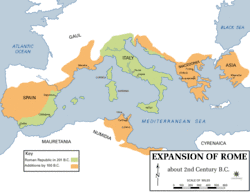
Expansion of Rome from 200 BC (green) to 100 BC (orange).
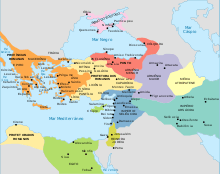
Roman holdings in the East (red), clients (pink), and other nations.
- Social War (90-88 BC)[1]
- 89 BC – Battle of Fucine Lake – Roman forces under Lucius Porcius Cato are defeated by the Italian rebels.
- 89 BC – Battle of Asculum – Roman army of C. Pompeius Strabo decisively defeats the rebels.
- First Mithridatic War (90-85 BC)
- 87 BC - 86 BC - Siege of Athens and Piraeus - Siege of Athens, which had sided with the Pontic invaders during the First Mithridatic War by Lucius Cornelius Sulla. Roman victory.
- 86 BC – Battle of Chaeronea – Roman forces of Lucius Cornelius Sulla defeat the Pontic forces of Archelaus in the First Mithridatic War
- 85 BC – Battle of Orchomenus – Sulla again defeats Archelaus in the decisive battle of the First Mithridatic War.
- First Marian-Sullan Civil War (88-87 BC)[1]
- 83 BC – Battle of Mount Tifata – Sulla defeats the popular forces of Caius Norbanus.
- Second Mithridatic War (83-82 BC)
- Sertorian War (83-81 BC)
- 80 BC – Battle of the Baetis River – Rebel forces under Quintus Sertorius defeat the legal Roman forces of Lucius Fulfidias in Hispania.
- Second Marian-Sullan Civil War (82-81 BC) [1]
- 82 BC –
- Battle of the Asio River – Quintus Caecilius Metellus Pius defeats a Popular army under Gaius Carrinas.
- Battle of Sacriporto – Fought between the Optimates under Lucius Cornelius Sulla Felix and the Populares under Gaius Marius the Younger, Optimate victory.
- First Battle of Clusium – Fought between the Optimates under Lucius Cornelius Sulla Felix and the Populares under Gnaeus Papirius Carbo, Popular victory.
- Battle of Faventia – Fought between the Optimates under Quintus Caecilius Metellus Pius and the Populares under Gaius Norbanus Balbus, Optimate victory.
- Battle of Fidentia – Fought between the Optimates under Marcus Terentius Varro Lucullus and the Populares under Lucius Quincius, Optimate victory.
- Second Battle of Clusium – Pompei Magnus defeats a numerically superior Populares army under Gaius Carrinas and Gaius Marcius Censorinus.
- Battle of Colline Gate – Sulla defeats Samnites allied to the popular party in Rome in the decisive battle of the Civil War.
- 82 BC –
- Third Mithridatic War (73-63 BC) [1]
- 73 BC – Battle of Cyzicus – Roman forces under Lucius Lucullus defeat the forces of Mithridates VI of Pontus
- 72 BC – Battle of Cabira or the Rhyndacus – Lucullus defeats the retreating forces of Mithridates, opening way to Pontus
- 69 BC – Battle of Tigranocerta – Lucullus defeats the army of Tigranes II of Armenia, who was harbouring his father-in-law Mithridates VI of Pontus
- 68 BC – Battle of Artaxata – Lucullus again defeats Tigranes.
- 66 BC – Battle of the Lycus – Pompey the Great decisively defeats Mithridates VI, effectively ending the Third Mithridatic War
- Third Servile War (73-71 BC)
- 73 BC – Battle of Mount Vesuvius – Spartacus defeats Gaius Claudius Glaber
- 72 BC – Battle of Picenum – Slave Revolt led by Spartacus defeat a Roman army led by Gellius Publicola and Gnaeus Cornelius Lentulus Clodianus
- 72 BC – Battle of Mutina I – Slave Revolt led by Spartacus defeat another army of Romans.
- 71 BC –
- Battle of Campania – Slave Revolt led by Spartacus defeat a Roman army.
- Battle of Campania II – a Roman army under Marcus Crassus defeats Spartacus's army of slaves.
- Battle of the Siler River – Marcus Crassus defeats the army of Spartacus.
- Pompey's Georgian campaign (65 BC)
- Catilinarian Civil War (63-62 BC)
- 62 BC, January – Battle of Pistoria – The forces of the conspirator Catiline are defeated by the loyal Roman armies under Gaius Antonius.
- Gallic Wars (59-51 BC)
- 58 BC –
- June – Battle of the Arar (Saône) – Caesar defeats the migrating Helvetii
- July – Battle of Bibracte – Caesar again defeats the Helvetians, this time decisively.
- September – Caesar decisively defeats the forces of the Germanic chieftain Ariovistus near modern Belfort
- 57 BC –
- Battle of the Axona (Aisne) – Caesar defeats the forces of the Belgae under King Galba of Suessiones.
- Battle of the Sabis (Sambre) – Caesar defeats the Nervii.
- Battle of Octodurus (Martigny) – Servius Galba defeats the Seduni and Veragri.
- 52 BC – Battle of Alesia – Caesar defeats the Gallic rebel Vercingetorix, completing the Roman conquest of Gallia Comata.
- 58 BC –
- War with the Parthian Empire (53 BC)
- 53 BC - Battle of Carrhae – Roman triumvir Crassus is disastrously defeated and killed by the Parthians. Crassus has molten gold poured down his throat by his captors.

The extent of the Roman Republic in 40 BC after Caesar's conquests.
- Caesar's Civil War (49-45 BC)
- 49 BC, June – Battle of Ilerda – Caesar's army surround Pompeian forces and cause them to surrender.
- 49 BC, 24 August – Battle of the Bagradas River – Caesar's general Gaius Curio is defeated in North Africa by the Pompeians under Attius Varus and King Juba I of Numidia. Curio commits suicide.
- 48 BC, 10 July – Battle of Dyrrhachium – Caesar barely avoids a catastrophic defeat by Pompey in Macedonia
- 48 BC, 9 August – Battle of Pharsalus – Caesar decisively defeats Pompey, who flees to Egypt
- 47 BC, February – Battle of the Nile – Caesar defeats the forces of the Egyptian king Ptolemy XIII
- 46 BC, 4 January – Battle of Ruspina – Caesar loses perhaps as much as a third of his army to Titus Labienus
- 46 BC, 6 February – Battle of Thapsus – Caesar defeats the Pompeian army of Metellus Scipio in North Africa.
- 45 BC, 17 March – Battle of Munda – In his last victory, Caesar defeats the Pompeian forces of Titus Labienus and Gnaeus Pompey the Younger in Hispania. Labienus is killed in the battle and the Younger Pompey captured and executed.
- War with Pontus
- 47 BC, May – Battle of Zela – Caesar defeats Pharnaces II of Pontus. This is the battle where he famously said Veni, vidi, vici. (I came, I saw, I conquered.)
- Liberators' civil war (44-42 BC)
- 43 BC, 14 April – Battle of Forum Gallorum – Antony, besieging Caesar's assassin Decimus Brutus in Mutina, defeats the forces of the consul Pansa, who is killed, but is then immediately defeated by the army of the other consul, Hirtius
- 43 BC, 21 April – Battle of Mutina – Antony is again defeated in battle by Hirtius, who is killed. Although Antony fails to capture Mutina, Decimus Brutus is murdered shortly thereafter.
- 42 BC, 3 October – First Battle of Philippi – Triumvirs Mark Antony and Octavian fight an indecisive battle with Caesar's assassins Marcus Brutus and Cassius. Although Brutus defeats Octavian, Antony defeats Cassius, who commits suicide.
- 42 BC, 23 October – Second Battle of Philippi – Brutus's army is decisively defeated by Antony and Octavian. Brutus escapes, but commits suicide soon after.
- Sicilian revolt (44-36 BC)
- 36 BC – Battle of Naulochus – Octavian's fleet, under the command of Marcus Vipsanius Agrippa defeats the forces of the rebel Sextus Pompeius.
- Fulvia's civil war (Perusine War) (41-40 BC)
- 41 BC – Battle of Perugia – Mark Antony's brother Lucius Antonius and his wife Fulvia are defeated by Octavian.
- Final War of the Roman Republic (32-30 BC)
- 31 BC, 2 September – Battle of Actium – Octavian decisively defeats Antony and Cleopatra in a naval battle near Greece.
- Cantabrian Wars (29-19 BC)
- 25 BC - Battle of Vellica - Roman forces under Augustus against the Cantabri people, Roman victory.
- 25 BC - Siege of Aracillum - Roman forces under Gaius Antistius Vetus against the Cantabri people, Roman victory.
- Germanic Battles (16-11 BC)
- Clades Lolliana (16 BC) – The troops of Consul Marcus Lollius Paulinus are defeated by West Germanic warriors in Gaul.
- Battle of the Lupia River (11 BC) – Roman forces under Augustus's stepson Drusus win a victory in Germany.
1st century
The Roman Empire under Augustus: The Republic in 31 BC (yellow) and Augustus's conquests (shades of green). Client states are in pink.
- Battle of the Teutoburg Forest (9) – German leader Arminius ambushes three Roman legions under Publius Quinctilius Varus.
- Battle of the Weser River (16) - Legions under Germanicus defeat German tribes of Arminius.
- Roman conquest of Britain (43-96)
- 43 – Battle of the Medway – Claudius and general Aulus Plautius defeat a confederation of British Celtic tribes. Roman invasion of Britain begins
- 50 – Battle of Caer Caradoc – British chieftain Caractacus is defeated and captured by the Romans under Ostorius Scapula.
- 71 - Battle of Scotch Corner
- 84 – Battle of Mons Graupius. Romans under Gnaeus Julius Agricola defeat the Caledonians.
- 58 – Sack of Artaxata by Gnaeus Domitius Corbulo during the Roman–Parthian War over Armenia
- 49 – The Siege of Uspe – Roman auxiliaries under Julius Aquila and King Cotys besiege the rebel forces of Siraces and Mithridates
- 59 – Capture of Tigranocerta by Corbulo.
- 62 – Battle of Rhandeia – Romans under Lucius Caesennius Paetus are defeated by a Parthian-Armenian army under King Tiridates of Parthia.
- Boudica's uprising (60-61)
- 60 – Battle of Camulodunum – Boudica begins her uprising against the Romans by capturing and then sacking Camulodunum then moves on Londinium.
- 61 – Battle of Watling Street – Boudica is defeated by Suetonius Paullinus
- First Jewish–Roman War (66-73) [1]
- 66 - Battle of Beth-Horon – Jewish forces led by Eleazar ben Simon defeat a Roman punitive force led by Cestius Gallus, Governor of Syria
- 73 – Battle of Masada
- 69 –
- Winter – Battle of 'Forum Julii' Othonian forces defeat a small group of Vitellianist auxiliaries in Gallia Narbonensis
- 14 April – Battle of Bedriacum – Vitellius, commander of the Rhine armies, defeats Emperor Otho and seizes the throne.
- 24 October – Second Battle of Bedriacum – Forces under Antonius Primus, the commander of the Danube armies, loyal to Vespasian, defeat the forces of Emperor Vitellius.
- 69 –
- Domitian's Dacian War (87-88)
- 87 – Dacian King Decebalus crushes the Roman army at Tapae (today Transylvania, Romania), Legio V Alaudae and general Cornelius Fuscus perish in battle.
- 88 – the Romans return and obtain a victory in the same battleground
2nd century

The extent of the Roman Empire under Trajan (117) The Empire is in red and dependencies are in pink.[2]
- First Dacian War (101-102)
- 101 – Second Battle of Tapae – Trajan defeats Decebalus, with heavy losses.
- 102 – Battle of Adamclisi - Roman forces led by Trajan annihilate a mixed Dacian-Roxolano-Sarmatae army, with heavy casualties on the Roman side.
- Second Dacian War (105-106)
- 106 – Battle of Sarmisegetusa – A Roman army led by Trajan conquers and destroys the Dacian capital. Part of Dacia is annexed to the Roman Empire.
- 114-117 – Trajan invades Parthia and occupies Ctesiphon.
- 161-165 – Roman–Parthian War — Vologases IV invades Armenia, but is pushed back and Ctesiphon is sacked.
- 195-197 – Septimus Severus invades, sacks Ctesiphon, and acquires northern Mesopotamia.
- Kitos War (115-117)
- Second Jewish Revolt (132-135)
- Marcomannic Wars (166-180)
- 170 – Battle of Carnuntum – Marcomannic King Ballomar defeats the Roman Army and invade Italy.
- 178-179 – Praetorian Prefect Teratenius Paternus defeats the Quadi.
- 179 or 180 – Battle of Laugaricio – Marcus Valerius Maximianus defeats the Quadi in Slovakia.
- 193 – Battle of Cyzicus – Septimius Severus, the new Emperor, defeats his eastern rival Pescennius Niger
- 193 – Battle of Nicaea – Severus again defeats Niger
- 194 – Battle of Issus – Severus finally defeats Niger.
- 197, 17 February – Battle of Lugdunum – Emperor Septimius Severus defeats and kills his rival Clodius Albinus, securing full control over the Empire.
3rd century
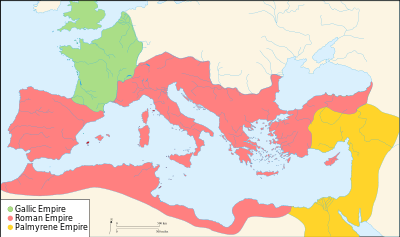
The Empires of Gaul (green), Rome (red), and Palmyra (yellow) in 271.
See Crisis of the Third Century
- Persian wars
- 217 – Battle of Nisibis – Bloody stalemate between the Parthians and the Roman army under Emperor Macrinus.
- 243 – Battle of Resaena – Roman forces under Gordian III defeat the Persians under Shapur I.
- 260 – Battle of Edessa – Emperor Shapur I of Persia defeats and captures the Roman Emperor Valerian
- 296 – Battle of Callinicum – Romans under the Caesar Galerius are defeated by the Persians under Narseh.
- Civil wars
- 218, 18 June – Battle of Antioch – Varius Avitus defeats Emperor Macrinus to claim the throne under the name Elagabalus.
- 238 – Battle of Carthage – Troops loyal to the Roman Emperor Maximinus Thrax defeat and kill his successor Gordian II.
- 274 – Battle of Châlons (274) – Aurelian defeats the Gallic usurper Tetricus, reestablishing central control of the whole empire.
- 285 – Battle of the Margus – The usurper Diocletian defeats the army of the Emperor Carinus, who is killed.
- Gothic and Alamannic wars
- 235 - late in the winter time - Battle of Harzhorn - Small Roman army defeats a German army while retreating back to Roman territory.
- 250 – Battle of Philippopolis – King Cuiva of the Goths defeats a Roman army.
- 251, 1 July – Battle of Abrittus – Goths defeat and kill the Roman Emperors Decius and Herennius Etruscus
- 259 – Battle of Mediolanum – Emperor Gallienus decisively defeats the Alemanni that invaded Italy
- 268 – Battle of Naissus – Emperor Gallienus and his generals Claudius and Aurelian decisively defeat the Goths.
- 268 – Battle of Lake Benacus – Romans under Emperor Claudius II defeat the Alemanni
- 271 – Battle of Placentia – Emperor Aurelian is defeated by the Alemanni forces invading Italy
- 271 –Battle of Fano – Aurelian defeats the Alamanni, who begin to retreat from Italy
- 271 –Battle of Pavia – Aurelian destroys the retreating Alemanni army.
- 298 –Battle of Lingones – Caesar Constantius Chlorus defeats the Alemanni
- 298 –Battle of Vindonissa – Constantius again defeats the Alamanni
- Palmyrene war
- 272 –Battle of Immae – Aurelian defeats the army of Zenobia of Palmyra
- 272 – Battle of Emesa – Aurelian decisively defeats Zenobia.
4th century
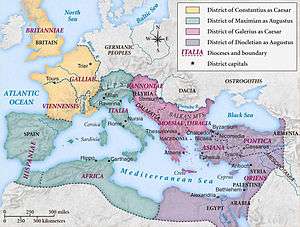
The Roman Empire under the Tetrarchy, with the territory of Constantius (yellow), Maximian (green), Galerius (pink), and Diocletian (purple)
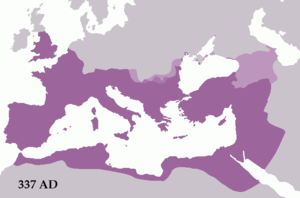
The Roman Empire in 337, showing the Empire under Constantine (shaded purple) and other Roman dependencies (light purple).
The 4th century begins with civil war resulting in the ascendancy of Constantine I, then, after his death, wars with Persia and Germanic tribes, punctuated frequently with more civil wars.
- Civil Wars of the Tetrarchy (306-324)
- 312 –
- Battle of Turin – Constantine I defeats forces loyal to Maxentius.
- Battle of Verona – Constantine I defeats more forces loyal to Maxentius.
- 28 October – Battle of Milvian Bridge – Constantine I defeats Maxentius and takes control of Italy.
- 313, 30 October – Battle of Tzirallum – In the eastern part of the Empire, the forces of Licinius defeat Maximinus.
- 314, 8 October – Battle of Cibalae – Constantine defeats Licinius
- 316 – Battle of Mardia – Constantine again defeats Licinius, who cedes Illyricum to Constantine.
- 324 –
- 3 July – Battle of Adrianople – Constantine defeats Licinius, who flees to Byzantium
- July – Battle of the Hellespont – Flavius Julius Crispus, son of Constantine, defeats the naval forces of Licinius
- 18 September – Battle of Chrysopolis – Constantine decisively defeats Licinius, establishing his sole control over the empire.
- 312 –
- Wars with Persia (344-363)
- c. 344 – Battle of Singara – Emperor Constantius II fights an indecisive battle against King Shapur II of Persia
- 359 – Battle of Amida – Sassanids capture Amida from Romans
- 363 – Battle of Ctesiphon – Emperor Julian defeats Shapur II of Persia outside the walls of the Persian capital, but is unable to take the city, and his death leads to an ultimate disaster on the retreat back to Roman territory.
- 351 – Battle of Mursa Major – Emperor Constantius II defeats the usurper Magnentius
- 353 – Battle of Mons Seleucus – Final defeat of Magnentius by Constantius II
- Wars with Alemanni (356-367)
- 356 – Battle of Reims – Caesar Julian is defeated by the Alamanni
- 357 – Battle of Strasbourg – Julian expels the Alamanni from the Rhineland
- 367 – Battle of Solicinium – Romans under Emperor Valentinian I defeat yet another Alamanni incursion.
- Civil War – 366 – Battle of Thyatira – The army of the Roman emperor Valens defeats the usurper Procopius.
- 377 – Battle of the Willows – Roman troops fight an inconclusive battle against the Goths
- 378 –
- Battle of Argentovaria – Western Emperor Gratianus is victorious over the Alamanni, yet again.
- 9 August – Battle of Adrianople – Thervings under Fritigern defeat and kill the Eastern Emperor Valens
- 380 – Battle of Thessalonica – The new Eastern Emperor, Theodosius I, is also defeated by the Thervings under Fritigern.
- Civil War – 388 – Battle of the Save – Emperor Theodosius I defeats the usurper Magnus Maximus.
- Civil War – 394 – Battle of the Frigidus – Theodosius I defeats and kills the usurper Eugenius and his Frankish magister militum Arbogast.
5th century
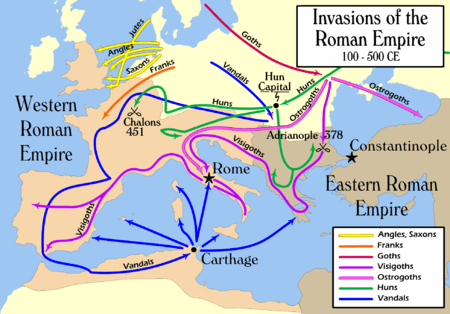
Map showing the paths of invasion by various groups into Eastern and Western Roman territory
The 5th century involves the final fall of the Western Roman Empire to Goths, Vandals, Alans, Huns, and Franks.
- Wars with Gothic Tribes (402-419)
- 402 –
- Battle of Pollentia – Stilicho defeats the Visigoths under Alaric.
- Battle of Verona – Stilicho defeats Alaric, who withdraws from Italy.
- 406 – Battle of Mainz – Franks lose to Vandals, Suebi and Alans.
- 410 – Sack of Rome – Visigoths under Alaric sack Rome.
- 419 – Battle of the Nervasos Mountains – Romans and Suebi defeat Vandals and Alans.
- 468 – Battle of Cap Bon - Failure of the invasion of the kingdom of the Vandals by the Western and Eastern Roman Empires
- 402 –
- Civil War – 432 – Battle of Ravenna – Bonifacius defeats rival Roman general Flavius Aetius, but is mortally wounded in the process.
- War with Visigoths – 436 – Battle of Narbonne – Flavius Aetius again defeats the Visigoths led by Theodoric.
- War with the Huns (447-451)
- 447 – Battle of the Utus – The Romans in the East fight an indecisive battle with Huns led by Attila.
- 451 – Battle of the Catalaunian Plains – The Romans with Flavius Aetius and the Visigoths with Theodoric, defend against Attila the Hun.
- Fall of the West (450-493)
- 455 – Sack of Rome by Geiseric, King of the Vandals
- 463 – Battle of Orleans – Gallo-Roman and Salian Frank forces under the command of Aegidius defeat a force of Visigoths at Orleans.
- 476 – Odoacer defeats the remnants of the Western Roman army, exiles emperor Romulus Augustulus, and declares himself King of Italy
- 486 – Battle of Soissons – Clovis I defeats Syagrius, last Roman commander in Gaul, and annexes the Roman rump state into the Frankish realm.
- 493 – Battle of Mons Badonicus – Romano-British under Ambrosius Aurelianus defeat Anglo-Saxons.
References
Sources
- Jones, Jim, (2013). Roman History Timeline. West Chester University of Pennsylvania. http://courses.wcupa.edu/jones/Roman History Timeline .
External links
- Elton, Hugh and Christos Nüssli, "Imperial Battle Map Index". An Online Encyclopedia of Roman Emperors.
- "Roman Battles" map, platial.com
This article is issued from
Wikipedia.
The text is licensed under Creative Commons - Attribution - Sharealike.
Additional terms may apply for the media files.